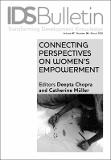| dc.contributor.author | Kabeer, Naila | |
| dc.date.accessioned | 2016-03-03T17:49:45Z | |
| dc.date.available | 2016-03-03T17:49:45Z | |
| dc.date.issued | 2016-03-03 | |
| dc.identifier.uri | https://opendocs.ids.ac.uk/opendocs/handle/20.500.12413/9696 | |
| dc.description.abstract | Poverty has not always been analysed from a gender perspective. Prior to the feminist contributions to poverty analysis, the poor were either seen as composed entirely of men or else women's needs and interests were assumed to be identical to, and hence subsumable under, those of male household heads. Gender research and advocacy has challenged the gender-blindness of conventional poverty measurement, analysis and policy in a number of different ways. Early research singled
out the female-headed households as a disproportionately represented category in the ranks of the poor (Buvinic and Youssef 1978; Kossoudji and Mueller 1983; Merrick and Schmink 1983). This particular link between gender and poverty was a relatively visible one in conventional poverty line measurement, since disaggregation by gender of head of household could easily be accommodated. Female heads of households as 'the poorest of the poor' consequently became - and have remained - a primary variable in the equation between gender and poverty. | en |
| dc.language.iso | en | en |
| dc.publisher | Institute of Development Studies | en |
| dc.relation.ispartofseries | IDS Bulletin;28.3 | |
| dc.rights.uri | http://www.ids.ac.uk/files/dmfile/IDSOpenDocsStandardTermsOfUse.pdf | en |
| dc.subject | Gender | en |
| dc.title | Editorial: Tactics and Trade-Offs Revisiting the Links Between Gender and Poverty | en |
| dc.rights.holder | Institute of Development Studies | en |
| dc.identifier.team | Gender and Sexuality | en |
| dc.identifier.doi | 10.19088/1968-2016.117 | |

